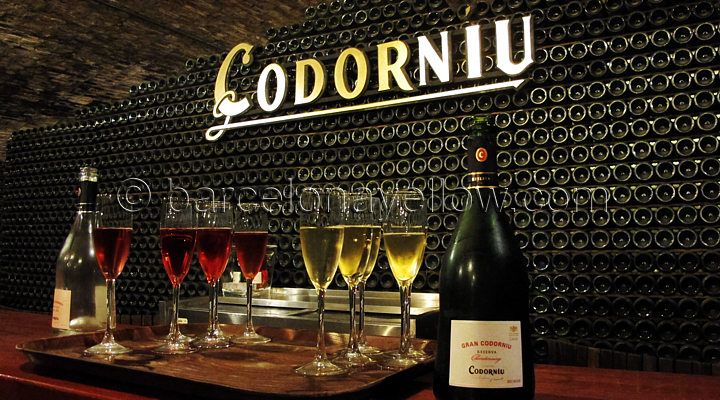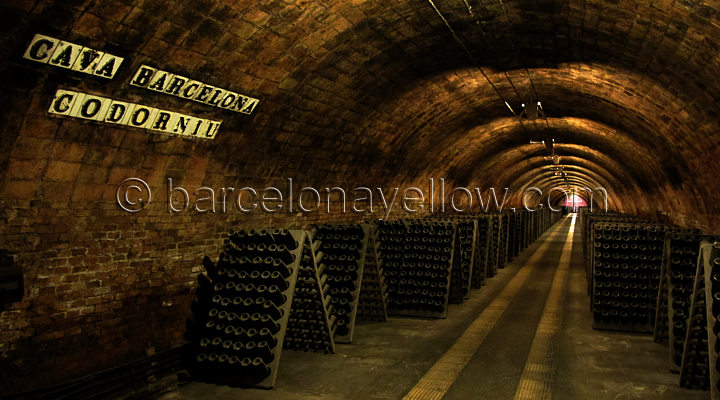| HOME |
| Hotels |
| Apartments |
| Attractions |
| Restaurants |
| Tickets & tours shop |
| Tours |
| Maps & travel planners |
| Airports & transport |
| Maps |
| Events |
| Shopping |
| Contact us |
|
| Cava Tours Barcelona |
 Cava Tours BarcelonaCatalonia is famous for Cava sparkling wine which comes from the central part of the Penedès wine making region of Spain. Penedès is located just 1 hour to the south-west of Barcelona which is convenient for cava tours from Barcelona. In Penedès there are many Cava vineyards and millions of bottles of delicious Cava are produced. Barcelona Cava and Wine Tours Penedès is one of Spain’s top wine-producing regions with its own wine classification system called 'Denominació d'Origen' (DO) which covers for wine and cava. Cava used to be known as 'Champaña' signifying Spanish champagne. However the name cava was officially used from the 1970's to distinguish Spanish champagne from French Champagne. This happened because under EU law only sparkling wine made in the Champagne district of France has the right to use the name of 'champagne' on the label. In other words a sparkling wine can only be called champagne if it comes from the region of Champagne in France. It was the French Benedictine monk Dom Pérignon (1638–1715) who first discovered champagne sparkling wine and developed the technique of making champagne. When Dom Pérignon first tasted sparkling wine, he is reputed to have said 'Come quickly, I am tasting stars.' Today his name lives on as the brand name of a famous brand of French champagne by Moët & Chandon.  So Spanish champagne is called Cava. The Catalan word 'cava' means cave or cellar. Cava wines ferment and age in the bottle in cellars or caves, so the name is perfect. The name Cava is now almost as famous as champagne and sparkling wine can only be called Cava if it comes from Spain. Cava is made using the same traditional methods as French champagne. This is called the 'méthode champenoise' - the champagne method. The French also won the right to use that name, so now Spanish Cava wineries call the way cava is made in Spain the 'méthode traditionnelle.' The traditional method basically means that the wine ferments a second time in the bottle and it is this second fermentation that produces the bubbles and creats sparkling wine. The most famous Cava brands and the most visited Cava wineries are Codorniu and Freixenet. But there are many more cava producers in Catalonia. In the town Sant Sadurni de Annoia alone there are over 80 cava producers. Codorniu is the flagship producer of Cava in the world making 60 million bottles of cava a year. Codorniu was also the first company to produce Cava in Spain in 1872 and can trace its winemaking roots back to the sixteenth century. The Cava industry in Spain was started after the Spanish red grape varieties were destroyed by the phylloxera epidemic which devasted wine regions in France and Spain in the late 19th century. After the phylloxera plague Codorníu decided to replant their vineyards with white grape varieties for sparkling wine production. Cava today is made with mostly Spanish grape varieties including xarello, perellada, macabeu and monastrell. How is Cava wine made? Grapes that are used to make cava are generally picked in early autumn in Spain early to get the right balance of sugar and acids. For cava the grapes should have a lower natural sugar levels and higher acid levels. The juice of harvested grapes is pressed off and the first fermentation begins in the same way as any wine - in large stainless steel vats. The fermentation process allows the natural sugar in the grapes to convert into alcohol while the carbon dioxide is allowed to escape. The result is a base wine, which is a still wine. This still wine is then blended into what is called a 'cuvée,' or a blend or different base wines.  A few grammes of yeast and a small amount of sugar is added to the blended wine. Then it is bottled, sealed with temporary plug, and stored in a dark cool wine cellar horizontally for the second fermentation and aging process in the bottle. The aging process in the bottle can last from from 12 months to five years. During this time the cava undergoes physical and chemical changes as well as changes in flavour and taste. The added yeast and sugar generates millions of carbon dioxide bubbles and raises the alcohol level very slightly. At the end of the bottle ageing period, the bottles must be clarified, so that the liquid is not cloudy. This is done using a technique called riddling. The bottles are placed at an horizontal angle in riddling racks and then gradually turned and tilted very slightly each day until all the yeast sediment is in the neck of the bottle and the liquid is completely clear. Then the yeast sediment can be removed. The next step in making cava is the disgorging process to remove the yeast sediment from the neck of the bottle. To to this necks of the bottles are frozen. When the temporary cap is removed, the frozen yeasts sediment is expelled by the pressure in the bottle. The bottle is then refilled and a tiny amount of liquor is added. This is known as dosage which takes place to adjust the degree of sweetness of the final cava. Finally, the cava bottle is sealed with the traditional cava cork and wire mesh. Then it is washed, labeled and ready to be sold and enjoyed all over the world. Cava classifications Cavas are classified by varying levels of sweetness, dryness which are determined by the sugar content. Of course the more sugar added the sweeter the cava. In wine terms the opposite of sweet is called dry. Sweet is DOLÇ in Catalan and DULCE in Spanish and dry is SEC in Catalan and SECO in Spanish . The driest cava is BRUT NATURE and the sweetest is DOLÇ BRUT NATURE: Up to 3 g/l, no sugar added BRUT Up to 12 g/l sugar EXTRA SEC Between 12 and 17 g/l sugar SEC Between 17 and 32 g/l sugar SEMISEC Between 32 and 50 g/l sugar DOLÇ: More than 50 g/l sugar Cava labels Cava has different quality labels which are determined by the length of time that the cava ages in the bottle during the second fermentation stage Cava: has aged a minimum of nine months in the bottle Cava Reserva: has aged a minimum of 15 months in the bottle Cava Gran Reserva: has aged a minimum of 30 months in the bottle © Copyright Barcelonayellow.com Do not copy from this page without permission All rights reserved. |
| Last Updated on Tuesday, 28 May 2019 19:31 |
|
|
Thursday, 18 September 2025

Barcelona Spain - Barcelona Travel Guide - Copyright 2007-2025
Privacy Policy and Cookies • Legal Disclaimer • Copyright
BarcelonaYellow SiteMap 2025
Barcelona Latest News:
COVID-19 - Barcelona Latest News
Barcelona Safety Guide 2025
Barcelona Top 10 attractions 20254
Plan 3 days in Barcelona 2025
About us
About us
Contact us
Privacy Policy and Cookies
Copyright notice
Legal disclaimer
Twitter Barcelona events
Partnerships
Advertising
COVID-19 - Barcelona Latest News
Barcelona Safety Guide 2025
Barcelona Top 10 attractions 20254
Plan 3 days in Barcelona 2025
About us
About us
Contact us
Privacy Policy and Cookies
Copyright notice
Legal disclaimer
Twitter Barcelona events
Partnerships
Advertising
Accommodation
Hotels in Barcelona
Hotels near Fira Exhibition
Hotels near Camp Nou
Hotels near Cruise Ships
Short Stay Apartments
Practical information
Useful visitor information
How to get to Barcelona airport
Cruise Ship Terminals
Barcelona maps
Airport buses
Barcelona metro
Taxis
Travel cards
Hotels in Barcelona
Hotels near Fira Exhibition
Hotels near Camp Nou
Hotels near Cruise Ships
Short Stay Apartments
Practical information
Useful visitor information
How to get to Barcelona airport
Cruise Ship Terminals
Barcelona maps
Airport buses
Barcelona metro
Taxis
Travel cards
Things to do
Top 10 attractions Barcelona
Photos of Barcelona
Restaurant Guide
Nightlife Guide
Things to do in Barcelona
Barcelona beaches
Book tours and tickets
Skiing near Barcelona
Weather Barcelona
Weather in Barcelona
5 day forecast Barcelona
Top 10 attractions Barcelona
Photos of Barcelona
Restaurant Guide
Nightlife Guide
Things to do in Barcelona
Barcelona beaches
Book tours and tickets
Skiing near Barcelona
Weather Barcelona
Weather in Barcelona
5 day forecast Barcelona
Top Festivals and events
Barcelona Events 2025
Christmas in Barcelona
New Years Eve 2025
MWC 2025 Barcelona
Sant Jordi's Day
Barcelona Marathon
Barcelona Half Marathon
Easter
Festa de Gracia
La Merce Festival
FC Barcelona calendar
Barcelona Events 2025
Christmas in Barcelona
New Years Eve 2025
MWC 2025 Barcelona
Sant Jordi's Day
Barcelona Marathon
Barcelona Half Marathon
Easter
Festa de Gracia
La Merce Festival
FC Barcelona calendar
Moving to Barcelona
Moving to Barcelona
Long term apartment rentals
Relocation agencies
Real estate agencies
Spanish schools
Meeting people
Finding work
Yellow pages directory
Partner websites:
DayTripsBarcelona.com
Stepbac.com
PhotoMemoirs.co
Helpfurl.com
Moving to Barcelona
Long term apartment rentals
Relocation agencies
Real estate agencies
Spanish schools
Meeting people
Finding work
Yellow pages directory
Partner websites:
DayTripsBarcelona.com
Stepbac.com
PhotoMemoirs.co
Helpfurl.com
